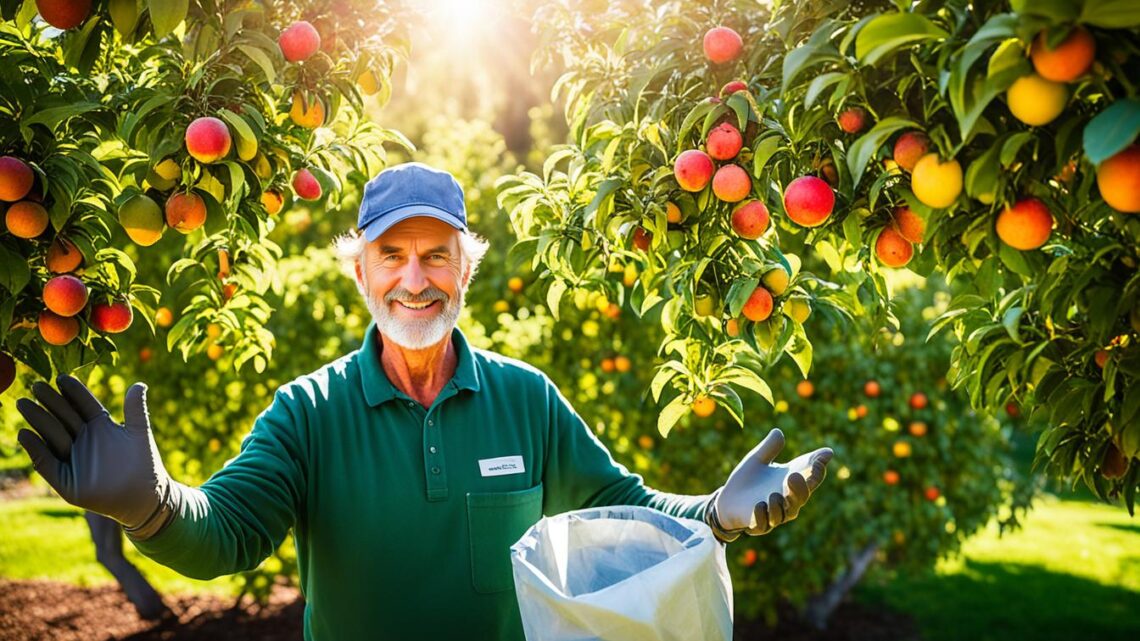
Are you having trouble getting a good harvest from your fruit trees? The secret to a great harvest might be in the right fertilization. What if you could find the key to feeding your trees and getting a big harvest? This guide will show you how to fertilize fruit trees to make them grow better, produce more, and stay healthy.
Getting fertilization right is key to your fruit trees doing well. We’ll cover the best times and ways to fertilize, and what types of fertilizers to use. This article will give you the info you need to make your orchard flourish. It doesn’t matter if you’re experienced or just starting, you’ll learn how to improve your fruit tree growing.
Understanding Apple Tree Nutrition
Keeping your apple trees healthy and productive means getting the right nutrients. These nutrients are like a special mix of elements. They include carbon, hydrogen, oxygen, phosphorus, potassium, nitrogen, sulfur, calcium, iron, magnesium, chlorine, molybdenum, boron, copper, manganese, and zinc.
Soil Assessment: The Foundation of Fertilization
Before you start fertilizing, test your soil. This test shows what nutrients your apple trees already have and the soil’s pH level. The best pH for fruit trees is between 6 to 6.5. In some places, it can be a bit higher, up to 6 to 7.
Selecting the Appropriate Fertilizer
After testing your soil, pick the right fertilizer. You’ll need nutrients like Nitrogen (N), Phosphorus (P), and Potassium (K). Nitrogen helps with leaf and shoot growth. Phosphorus is good for roots and flowers. Potassium keeps the tree healthy and strong against diseases.
Other nutrients like Calcium, Boron, Manganese, Zinc, and Iron are also key but in smaller amounts. They help with photosynthesis and keeping the tree strong. Some apple types, like Honeycrisp, need more Calcium.
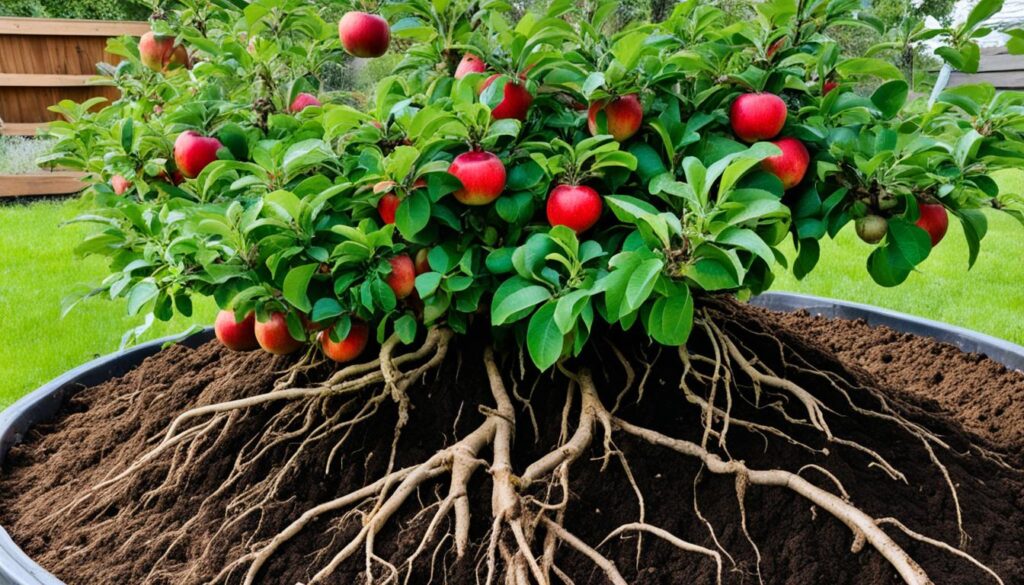
When to apply fertilizer depends on where you live, usually from early spring to July 1st. Some apple trees need more Nitrogen than others. Always follow the fertilizer instructions and adjust as needed.
Optimal Fertilization Timing
The timing of fertilizer application is key for fruit trees. It affects how well they take in nutrients and stay healthy. Here are the best times to fertilize your fruit trees:
- Early Spring: Give fertilizer right before buds start to open, usually in early spring. This helps the roots get the nutrients they need for growth.
- Throughout Summer: Keep fertilizing your fruit trees in the summer. But don’t give them nitrogen after July. This prevents growth that might get damaged in winter.
How much nitrogen your fruit trees need depends on their age or trunk size. New trees need about 0.10 pounds of nitrogen per year or per inch of trunk size. The most you should give is 1 pound of actual nitrogen a year. Adjusting the fertilizer based on your trees’ needs ensures they grow well and produce lots of fruit.
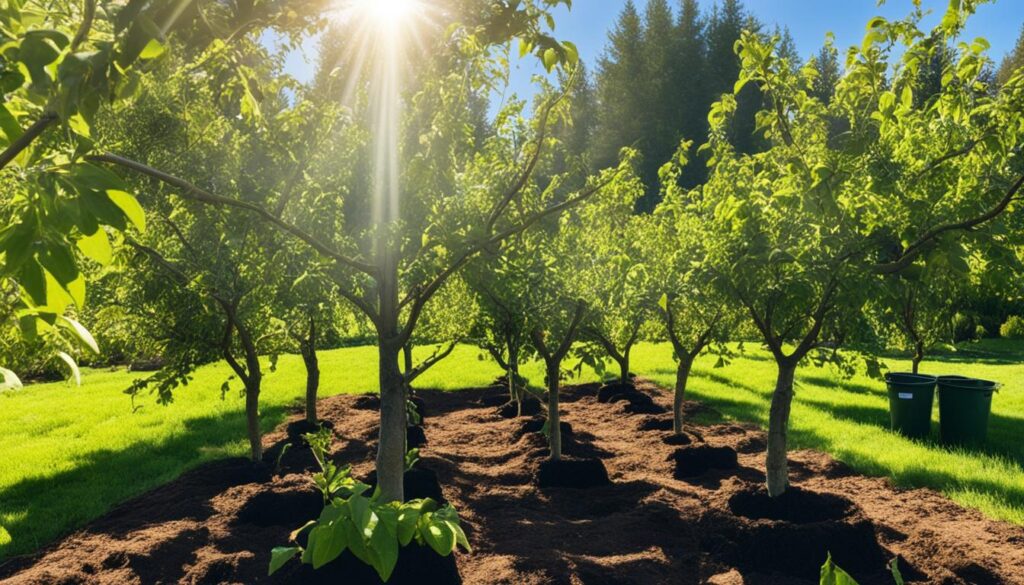
By following these fertilizing schedule for fruit trees, you give your trees the right nutrients at the best times. This helps them do well and gives you a big harvest. Always check with local experts or horticulturists for advice on when to fertilize fruit trees in your area and for your specific trees.
Fertilizer Application Techniques
Using the right way to apply fertilizers can really help your fruit trees grow better. Whether you pick organic fertilizers or synthetic ones, knowing how to do it right is key. It helps trees take in nutrients better and stay healthy.
Organic Fertilizers
For organic fertilizers like compost, manure, or bone meal, spread it around the tree’s drip line. This is where most of the feeder roots are. Make sure to mix it into the soil well so the roots can easily get to it.
Synthetic Fertilizers
Synthetic fertilizers, such as 10-10-10 or nitrogen-based ones, can be used in different ways. Some people spread it on the ground, while others put it in furrows or trenches near the tree. Just remember, don’t pile it up at the tree’s base. It can cause nutrient problems and harm the tree.
When to apply organic fertilizers for fruit trees or synthetic fertilizers for fruit trees is also important. Experts often suggest using half the fertilizer in early spring and the other half in late spring or early summer.
Learning the best techniques for applying fertilizer to fruit trees helps your trees get the nutrients they need. This way, they can grow well and give you a big harvest.
Optimizing Apple Orchard Layout and Tree Management
The way you arrange and care for your apple orchard greatly affects how well your trees get nutrients. Using the right fruit tree spacing and pruning techniques helps trees get enough light and air. This makes them use nutrients better.
Ideal Fruit Tree Spacing
When setting up your apple orchard, think about how big the trees will get. Make sure to leave enough space between them. Too close together can block air and light, and make it hard for trees to get nutrients. Apple trees should be 12-18 feet apart in rows, with 18-24 feet between rows.
This setup lets trees grow well and get what they need to do great.
Pruning for Optimal Tree Health
Pruning your fruit trees often is key to keeping them strong and productive. By cutting back some branches and removing sprouts, you help air move and light get in. This helps trees use nutrients better, making their fruit taste better and grow more.
| Nutrient | Optimal Soil Levels for Apple Trees |
|---|---|
| Nitrogen (N) | 30-50 ppm |
| Phosphorus (P) | 20-30 ppm |
| Potassium (K) | 100-150 ppm |
| Calcium (Ca) | 1000-1500 ppm |
| Magnesium (Mg) | 100-200 ppm |
| Zinc (Zn) | 5-10 ppm |
| Iron (Fe) | 4.5-5.5 ppm |
| Soil pH | 6.0-7.0 |
By arranging your fruit tree layout well and pruning right, you help your apple trees grow strong. This makes your fertilizing work better.
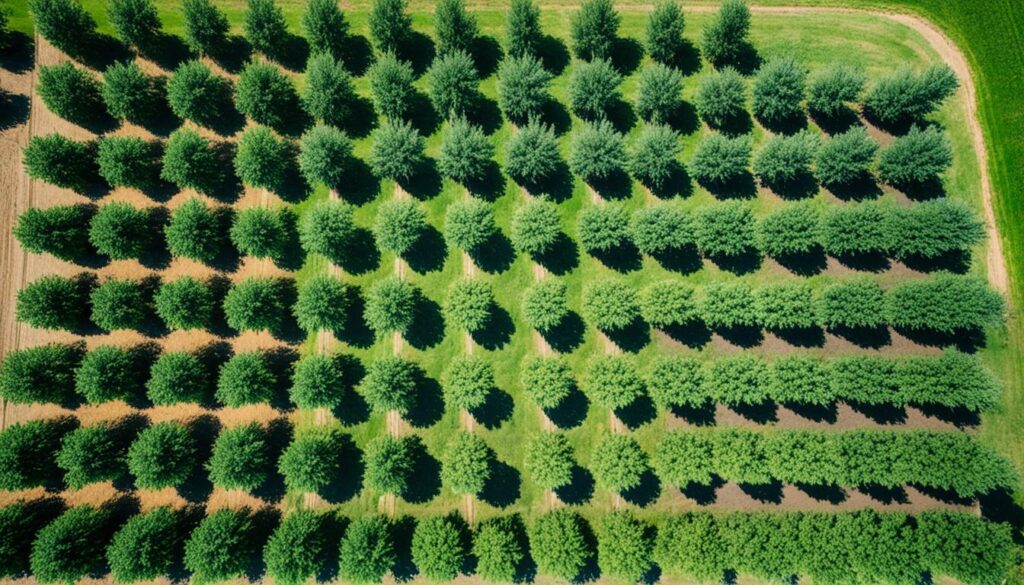
Training and Pruning Techniques
Proper pruning and training are key for your fruit trees. Pruning removes dead, damaged, or unproductive wood. This lets in more light, air, and nutrients.
The strongest crotch angle for a limb is 45 to 60 degrees. Thin out shoots at the end of branches to make fruit bigger and better.
Sweet cherry trees can be pruned in August to avoid bacterial infection. Bending limbs 45 to 60 degrees from vertical helps increase fruit early on.
The Open Center system trains trees to choose a few main branches. A post-and-wire trellis system for Espalier uses wires at 2-foot intervals, starting 4 feet off the ground.
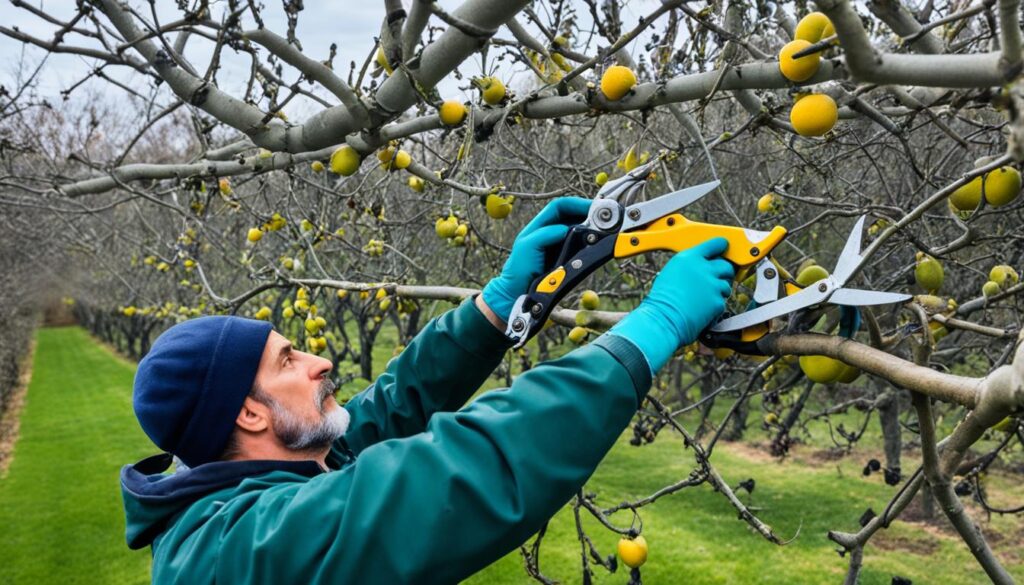
Peaches bloom on 1-year-old wood. Apples bloom on 2-year-old wood. Cherries, plums, pears, and apples need good light for fruiting.
Prune fruit trees in the dormant season, from December to February. Thinning cuts remove branches at their start or shorten them.
Heading cuts cut a plant back to a bud or small branch at a 45° angle. This is done ¼ inch above the bud.
- The «Y» system works well for peaches and nectarines. Trees should be six to seven feet apart, with rows 15 feet apart.
- For apples, plums, pears, and cherries, space trees eight to ten feet apart.
Prune trees in the dormant season for better visibility and to boost growth. After planting a new tree, cut it to a short stick and remove any low side shoots.
- Young trees should be pruned heavily and grown fast for the first three years without fruit.
- Upright branches stay vegetative, while horizontal branches produce more fruit.
Peach and nectarine trees need 50% of last year’s growth removed. Fig, apple, pear, plum, and apricot trees should lose about 20%.
Rejuvenating a neglected tree is easier over two or three years than in one.
Pest and Disease Management
Keeping your fruit trees healthy is more than just feeding them well. They can face many fruit tree pests and fruit tree diseases. These can hurt their growth and even kill them if not stopped. Using integrated pest management (IPM) is key to making your fertilizing work.
Many pests can harm fruit trees, like apple maggots and Japanese beetles. These pests can damage leaves, flowers, and fruit. This can lower the tree’s health and the amount of fruit it produces. Diseases like apple scab and powdery mildew can also hurt your trees.
It’s important to watch your trees for pests and diseases. You might need to set traps or check leaves and fruit often. Catching problems early lets you fix them fast. This could mean using organic or synthetic pesticides or pruning the tree.
| Pest/Disease | Description | Management Approach | Preharvest Interval |
|---|---|---|---|
| Codling Moth | Larvae cause holes in fruit from outside to core | Spinosad, Esfenvalerate | 7-28 days |
| Apple Scab | Fungal disease causing lesions on leaves and fruit | Captan, Myclobutanil | 1-14 days |
| Japanese Beetle | Metallic-green beetles that skeletonize leaves | Pyrethrins | 1 day |
By being careful and using a good integrated pest management plan, you can keep pests and diseases away from your fruit trees. This way, you’ll have a great harvest every year.
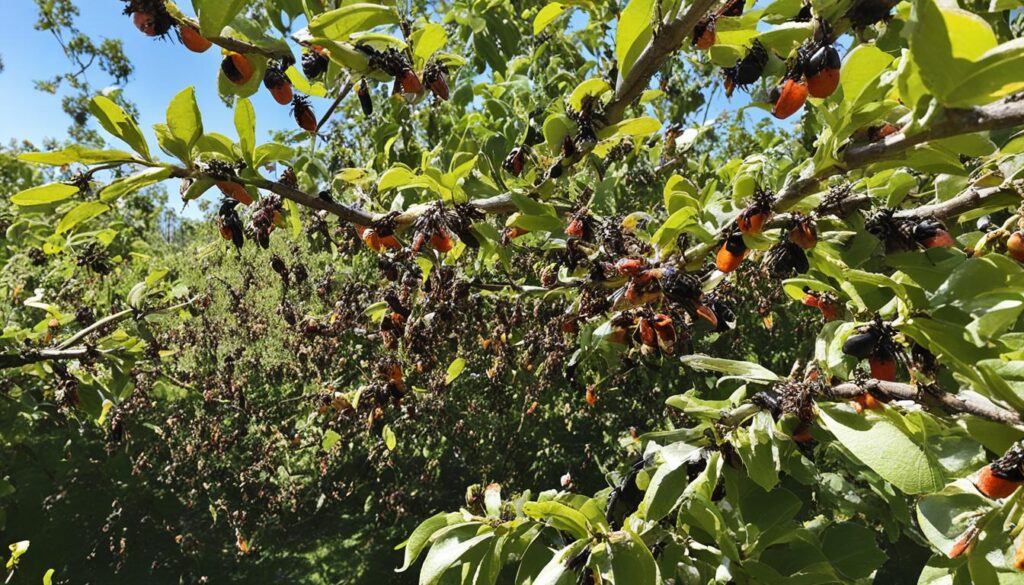
The Importance of Mulching
Putting organic mulch around your fruit trees has many benefits. It helps your fertilizing efforts. Mulch does a lot for your trees.
- Retains soil moisture by stopping evaporation. This means you water less often.
- Suppresses weed growth, so your trees get more nutrients and water.
- Insulates the soil, keeping tree roots safe from big temperature changes.
- Improves soil structure and fertility as it breaks down.
Choosing the right mulch for your trees is important. Here are some good options:
| Mulch Type | Benefits | Drawbacks |
|---|---|---|
| Cedar bark mulch | Keeps weeds away, holds moisture, and keeps insects away. | None |
| Hardwood mulch | Breaks down quickly, adding nutrients to the soil. | None |
| Pine mulch | Not good for fruit trees because it makes soil too acidic. | Acidic soil |
| Compost and manure | Full of nutrients, makes soil better at holding water. | None |
| Leaf mold | Adds a little nutrition and makes soil better. | Not very nutritious |
| Straw mulch | Keeps moisture in, protects roots, and gives nutrients later. | None |
Using different mulches together, like wood and compost, works best. Don’t put mulch right up against the tree trunk to avoid bark damage. With the benefits of mulch for fruit trees, your orchard will be healthy and strong.
fertilizing fruit trees
It’s key to fertilize your fruit trees right for their health, growth, and fruit production. Knowing when, how, and what to use can help your trees grow well and give you lots of fruit. Let’s look at the main parts of fertilizing fruit trees.
Timing is Everything
The best time to feed your fruit trees changes with the tree type and age. Apple trees do well with early spring fertilizing, a couple of weeks before buds open. This helps the roots get nutrients for the season. Pear trees also like spring feeding, while stone fruit trees (like peaches and plums) only need it if they had fruit the year before.
Tailoring the Fertilizer
Picking the right fertilizer is key for your trees’ needs. Fruit trees need 16 key nutrients, with big needs for nitrogen, phosphorus, and potassium. Organic stuff like manures and compost gives nutrients slowly. Synthetic fertilizers give nutrients fast but you might need to use them more often.
| Tree Type | Fertilizer Recommendation |
|---|---|
| Young Apple Trees (1-3 years) | Add a foot (30 cm) of growth annually to determine fertilizer needs |
| Mature Apple Trees (4+ years) | Increase nitrogen by up to 50% if annual growth is insufficient |
| Pear Trees | Apply 1 pound (453.5 g) of calcium nitrate in the spring if annual growth is under 6 inches (15 cm) |
| Stone Fruit Trees | Fertilize only if they set a crop the previous year, with options like 1 pound (453.5 g) of calcium nitrate or 1 ½ lb. (680 g) of 10-10-10 fertilizer |
The amount of fertilizer your trees need depends on their age, size, and nutrient needs. Talk to a local expert to find the best fertilizer and how much to use for your trees.
Follow these tips to help your fruit trees grow strong and give you lots of fruit. Knowing when to fertilize fruit trees and how to fertilize fruit trees with the right fruit tree fertilizer is key to their health and fruit production.
Achieving Orchard Success
To make a fruit tree orchard successful, you need to do more than just fertilize. You must also follow other important steps. By using the tips from this guide, you can make your orchard healthy and full of fruit. This way, you’ll have a sustainable fruit tree care plan.
Susan Poizner is a top expert in fruit trees. She runs Orchard People Fruit Tree Care Consulting and Education in Toronto, Canada. Poizner has taught thousands of new growers how to care for fruit trees. She also wrote several books that won awards.
Choosing the right fruit tree varieties is key for a thriving orchard. Visit local nurseries to pick trees that fit your climate and soil. Knowing how many chill hours each tree needs, like apples or cherries, helps plan your orchard well.



